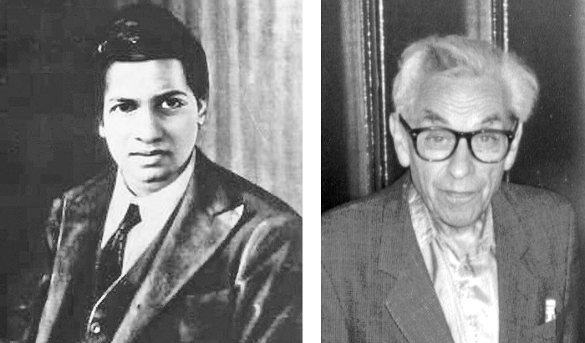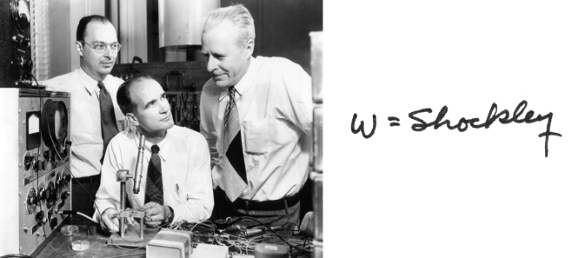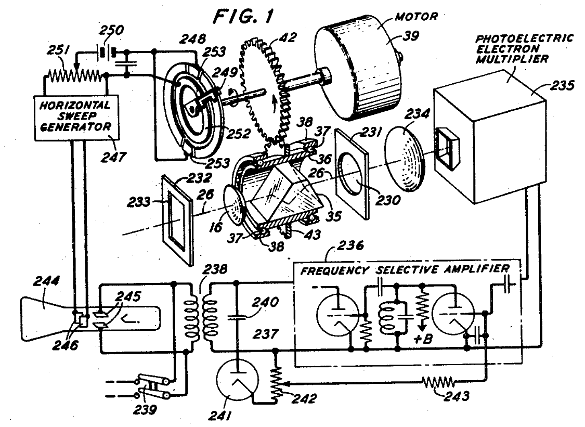The Multifaceted William Shockley
July 20, 2020
Scientists and
mathematicians seem to act differently than most individuals. There are both positive and negative aspects of this. On the positive side, we have
data-driven decision making that's so much needed in today's world. The negative side is illustrated in the lives of many such prominent people.
For mathematicians, there's the
obsession with work that likely contributed to the early
death of
Srinivasa Ramanujan (1887-1920) at age 32.
Paul Erdős (1913-1996) was another
workaholic mathematician; but, unlike Ramanujan, Erdős lived to be 83. Erdős lived his later life as a
homeless person. He relied on his mathematician
colleagues to provide occasional
room and board and to
tend to his finances.

Srinivasa Ramanujan (1887-1920) (left), and Paul Erdős (1913-1996) (right). (Left image and right image, both from Wikimedia Commons.)
Mathematician,
Kurt Gödel, famous for his
incompleteness theorems, died from
malnutrition by
believing that people were trying to
poison him.
John Forbes Nash, who shared the
Nobel Prize in Economics in 1994 for the development of
game theory, suffered from
paranoid schizophrenia, as detailed in
Sylvia Nasar's book,
A Beautiful Mind.[1] Nash fortunately recovered from his
mental illness, only to be killed with his wife in a tragic
2015 automobile accident after his award of the
Abel Prize. It should be noted that a contributing cause of death was the couple's not wearing
seat belts.
Among
physicists, the
taciturn,
Paul Dirac (1902-1984), stands as an interesting example, so much so that one of his
biographies is entitled,
The Strangest Man.[2] The title of this biography, by
Graham Farmelo, apparently derives from
Niels Bohr's assessment that Dirac was the "the strangest man" who had visited
his laboratory. It's said that Dirac's
Cambridge University colleagues invented a
unit, the
dirac, which had a value of one
word per
hour.[2] While more curious than strange, physicist,
Richard Feynman (1918-1988), is well known for his extra-physical interests and activities.[3]
Physicist,
William Shockley (1910-1989), was
co-inventor of the
transistor, he shared in the 1956
Nobel Prize for Physics with his
Bell Labs colleagues,
John Bardeen (1908-1991) and
Walter Brattain (1902-1987), and he is listed as an inventor on more than 90 US
patents. Shockley had a generally
paranoid and
domineering personality, as evidenced by his
leadership at the
Shockley Semiconductor Laboratory.
These
traits became exaggerated after he was seriously
injured in an automobile accident in July, 1961. While he seemed to recover fully from his injuries after a few months, he became an embarrassment to
Stanford University; and, to Bell Labs, for which he remained a
consultant. He became combative and
socially isolated, and became
estranged from his
children, who only learned of his death in 1989 from
news reports. He promoted
racial superiority and
eugenics.

This photograph shows the three inventors of the transistor: John Bardeen (1908-1991) (left), William Shockley (1910-1989) (center) and Walter Brattain (1902-1987) (right), as shown in a 1948 Bell Labs press release in connection with the announcement of this invention on June 30, 1948). As demonstrated by the invention of the telephone and laser, all important inventions come with controversy. Shockley was not a designated inventor on the 1948 patent application for the transistor, and it was a Bell Labs political decision that he should be considered one of the inventors, since he was one of the leaders of the solid state physics group that had Bardeen and Brattain among its members.
On the right is Shockley's signature, scanned from a 1980 letter from him in which he included a requested reprint of a paper on dislocations in electronic materials, and also some of his racist propaganda.
(Left, Wikimedia Commons image. Right, a scan from my personal files. Click for larger image.)
The early life of a scientist can be
predictive of his later life. Shockley was born in
London, England, to
American parents who were
technical professionals.[4] His
father, a
mining engineer, and
mother, a
mineral surveyor, settled in
Palo Alto, California, when Shockley was three years of age. They
educated him at
home until he was eight, since they thought they could do a better at teaching him than the
public schools.[4] His parents emphasized
mathematics and
science in his education, and he was influenced by a physicist
neighbor.[4]
It was observed that Shockley's mental disorders may have derived from his parent's being strongly paranoid.[5] Shockley was granted a
Ph.D. from
MIT for a
dissertation entitled, "
Calculation of
Electron Wave Functions in
Sodium Chloride Crystals."[4]
Shockley left Bell Labs in 1956 to found the Shockley Semiconductor Laboratory in in
Mountain View, California, near Stanford University. At the end of that same year, Shockley shared the
1956 Nobel Prize in Physics with Bardeen and Brattain "for their researches on semiconductors and their discovery of the transistor effect." Shockley's
management style eventually caused eight of his
employees, known as the
traitorous eight, to leave in 1957 and found
Fairchild Semiconductor to produce inexpensive
silicon transistors.

Figure 1A from US Patent no. 2,524,035, 'Three-electrode circuit element utilizing semiconductive materials,' by John Bardeen and Walter Brattain, October 3, 1950.[6] Shockley is not listed as an Inventor. (Via Google Patents.[4])
Shockley was good at physics, despite his personal failings.[7-9] The
Shockley partial dislocation, a
dislocation that's important since it's easily able to glide along
fault planes, is named after him. He discovered this type of dislocation in 1947. In 1950, Shockley published his major work, the book,
Electrons and Holes in Semiconductors (1950).
One possible organizing principle in Shockley's
career can be found in a 2013 article by David C. Brock in
IEEE Spectrum.[10] Much of the science that Shockley pursued was motivated by a desire to replace both
domestic workers and
factory workers with a
robotic workforce.[10] Brock makes the case that it all started with a patent application for an
image sensor filed on March 19, 1948, at about the same time as the invention of the transistor.[10] This invention compared a visual scene with images on a roll of
photographs to derive a
control signal.[11] One application was for a
guided bomb, but the device could be used for such things as
facial recognition and
component inspection.[11]

Figure 1 from US Patent no. 2,884,540, "Radiant energy control system," by William Shockley, April 28, 1959. As one whose history parallels that of transistor technology, it's interesting to see illustrations of the various mechanical and vacuum tube elements that were needed to accomplish things 70 years ago. (Via Google Patents.[11] Click for larger image.)
Shockley convinced Bell Labs to let him retain the
intellectual property to improvements on this invention. Eventually, he tried to convince
Mervin Kelly (1895-1971),
president of Bell Labs and a physicist himself, to start research in using his "optoelectronic eye" to kick-start robot development, but Kelly wasn't interested. His robot eye patent was granted in December 1954 (but held
secret until 1959).[11] Early in 1955, he was invited to an event honoring him, and also
Lee de Forest (1873-1961), inventor of the
triode vacuum tube.[10] At this event, Shockley met
Arnold Beckman (1900-2004).[10]
Beckman was a Ph.D.
chemist who invented a commercially successful
pH meter and a high-precision
potentiometer, the Helipot.[10] Beckman had also worked at Bell Labs, where he acquired the electronics skill needed for his pH meter.[10] Beckman was also an advocate of
automation, and in 1955 he funded the foundation of Shockley Semiconductor Lab as a part of Beckman Instruments for the manufacture of
diffused silicon transistors.[10]
Physicist,
Frederick Seitz (1911-2008), who was the 17th president of the
National Academy of Sciences from 1962-1969, and an acquaintance of Shockley during his student days, said this about Shockley:
"[Shockley] was unable to place himself in the shoes of others and thereby understand that advocating strong eugenic measures in a highly diverse society is bound to be highly disruptive. Yet he advocated that such a course be followed to the very end of his life... He was inclined to believe that society should be governed by what one might regard as an intellectually elite group... rather than by majority decisions as in a democratic society."[4]
References:
- Sylvia Nasar, "A Beautiful Mind," Simon & Schuster, July 12, 2011, 464 pp., ISBN: 978-1451628425 (via Amazon).
- Graham Farmelo, "The Strangest Man: The Hidden Life of Paul Dirac," Basic Books, June 28, 2011, 560 pp., ISBN: 978-0465022106 (via Amazon).
- Richard P. Feynman and Ralph Leighton, "Surely You're Joking, Mr. Feynman!": Adventures of a Curious Character," W. W. Norton & Company, February 6, 2018, 400 pp., ISBN: 978-0393355628 (via Amazon).
- John L. Moll, "William Bradford Shockley 1910—1989, A Biographical Memoir. National Academies Press, (Washington D.C.: 1995).
- Christophe Lécuyer, "Review of Broken Genius: The Rise and Fall of William Shockley, Creator of the Electronic Age," Physics Today, vol. 60, no. 2 (February 1, 2007, pp. 64f.), https://doi.org/10.1063/1.2711641.
- John Bardeen and Walter H Brattain, "Three-electrode circuit element utilizing semiconductive materials," US Patent no. 2,524,035, October 3, 1950.
- Joel N. Shurkin, "Broken Genius: The Rise and Fall of William Shockley, Creator of the Electronic Age," Palgrave Macmillan, June 13, 2006, 297 pp., ISBN: 978-0230551923 (via Amazon).
- William B. Shockley Biographical, Nobel Prize Foundation, 1956.
- Lillian Hoddeson, Interview of William Shockley at Murray Hill, New Jersey, September 10, 1974, AIP Oral Histories.
- David C. Brock, "How William Shockley’s Robot Dream Helped Launch Silicon Valley," IEEE Spectrum, November 29, 2013.
- William Shockley, "Radiant energy control system," US Patent no. 2,884,540, April 28, 1959.
Linked Keywords: Scientist; mathematician; data-informed decision-making; data-driven decision making; workaholic; obsession with work; death; Srinivasa Ramanujan (1887-1920); Paul Erdős (1913-1996); homelessness; homeless person; colleague; room and board; financial adviser; finances; Wikimedia Commons; Kurt Gödel; incompleteness theorems; malnutrition; persecutory delusion; belief; poison; John Forbes Nash; Nobel Memorial Prize in Economic Sciences; Nobel Prize in Economics; game theory; paranoid schizophrenia; Sylvia Nasar; A Beautiful Mind (book); mental illness; 2015 automobile accident; Abel Prize; seat belt; physicist; taciturn; Paul Dirac (1902-1984); biography; The Strangest Man; Graham Farmelo; Niels Bohr; Niels Bohr Institute; University of Cambridge; Cambridge University; unit of measurement; word per hour; Richard Feynman (1918-1988); William Shockley (1910-1989); invention; co-inventor; transistor; Nobel Prize for Physics; Bell Labs; John Bardeen (1908-1991); Walter Brattain (1902-1987); patent; paranoia; paranoid; domination; domineering; personality; leadership; Shockley Semiconductor Laboratory; trait theory; trait; injury; injured; Stanford University; consultant; social isolation; socially isolated; family estrangement; estranged; child; children; news report; supremacism; racial superiority; eugenics; photograph; publicity; press release; telephone; Gordon Gould; laser; controversy; patent application; politics; political; solid state physics; autograph; signature; image scanner; scanned; letter (message); reprint; scientific literature; paper; dislocations; semiconductor; electronic material; racism; racist; propaganda; prediction; predictive; London, England; American; parents; technology; technical; professional; father; mining engineer; mother; mineral; surveyor; Palo Alto, California; education; educated; home; public school; mathematics; science; neighbourhood; neighbor; Doctor of Philosophy; Ph.D.; Massachusetts Institute of Technology; MIT; thesis; dissertation; calculation; electron; wave function; sodium chloride; crystal; Mountain View, California; 1956 Nobel Prize in Physics; management; employee; traitorous eight; Fairchild Semiconductor; silicon; US Patent no. 2,524,035; Google Patents; Shockley partial dislocation; dislocation; stacking fault; fault plane; Electrons and Holes in Semiconductors; career; IEEE Spectrum; domestic worker; factory worker; robot; robotic; image sensor; photograph; corrective feedback; control signal; guided bomb; facial recognition; quality control; component inspection; machine; mechanical; vacuum tube; intellectual property; Mervin Kelly (1895-1971); president (corporate title); secrecy; secret; Lee de Forest (1873-1961); Audion; triode vacuum tube; Arnold Orville Beckman (1900-2004); chemist; pH meter; potentiometer; automation; diffused junction transistor; diffused silicon transistor; Frederick Seitz (1911-2008); National Academy of Sciences; diversity (politics); diverse society; society; intellectual; elite; democracy; democratic society.